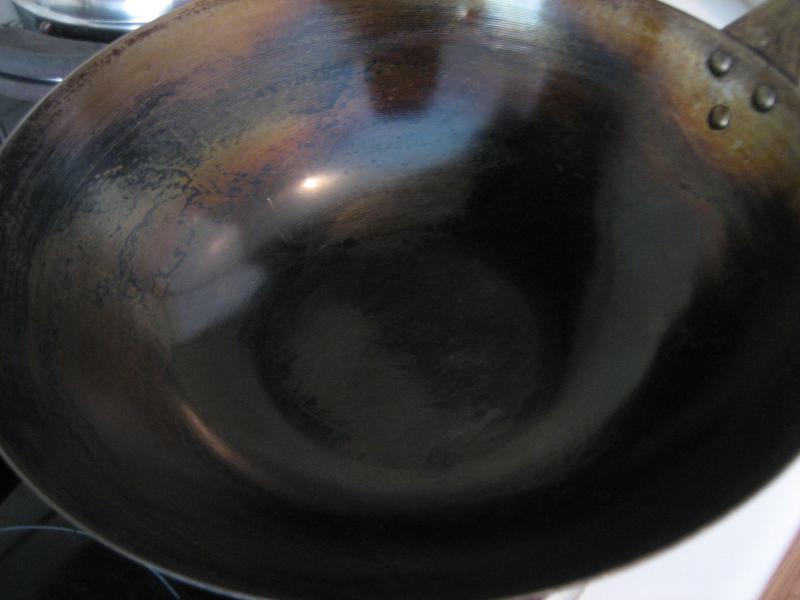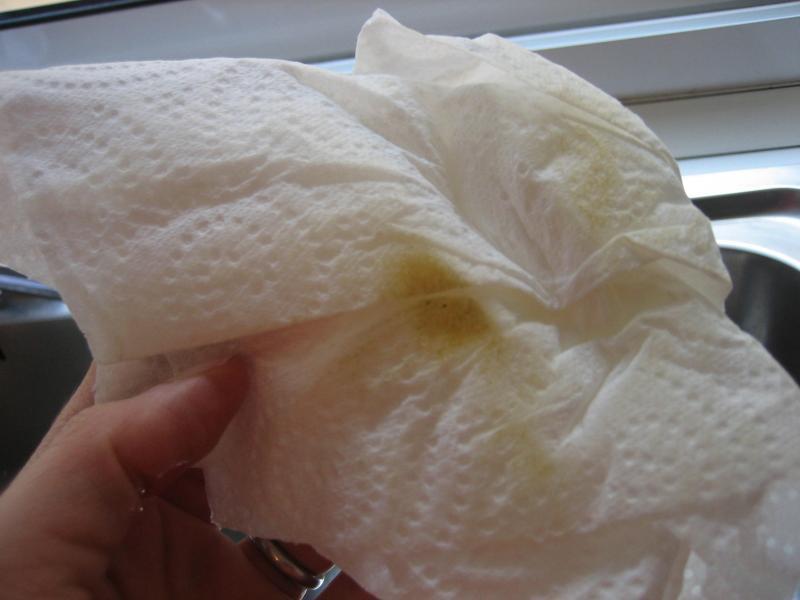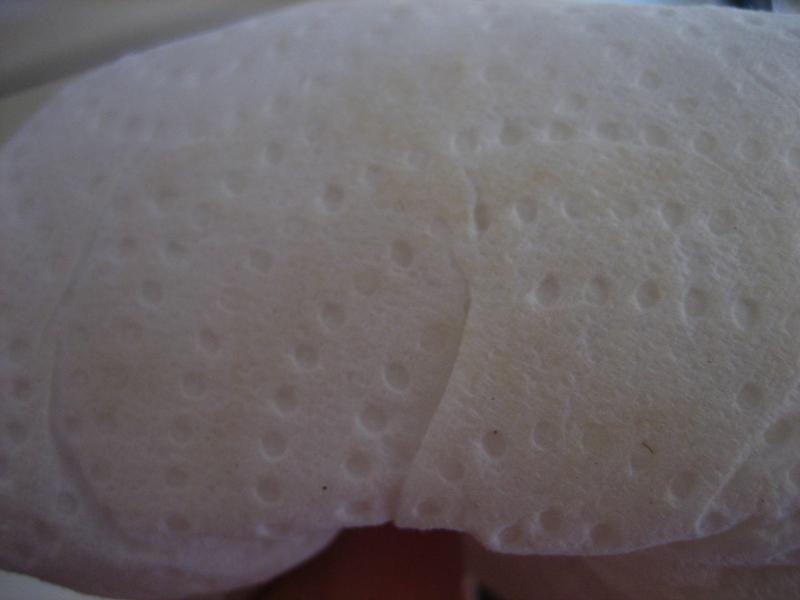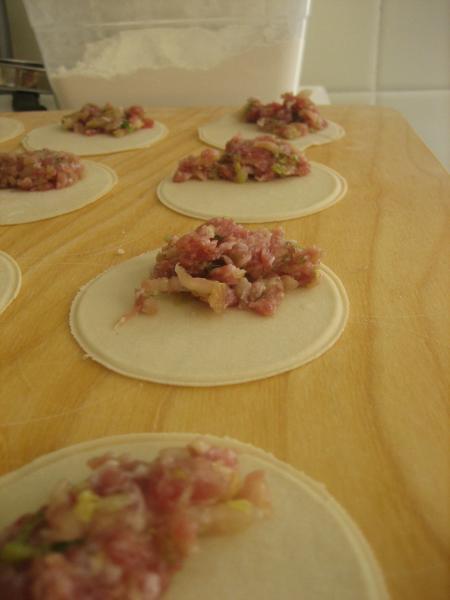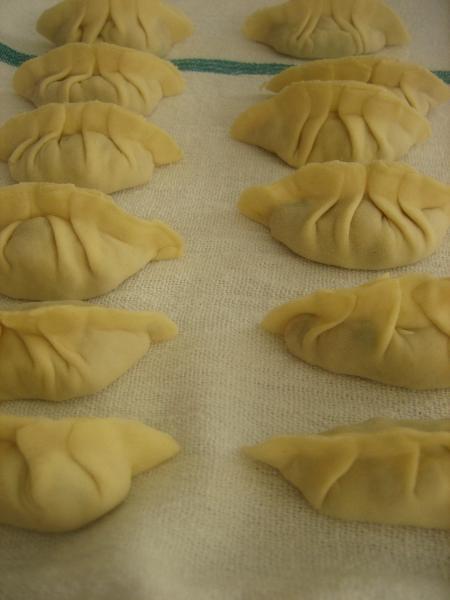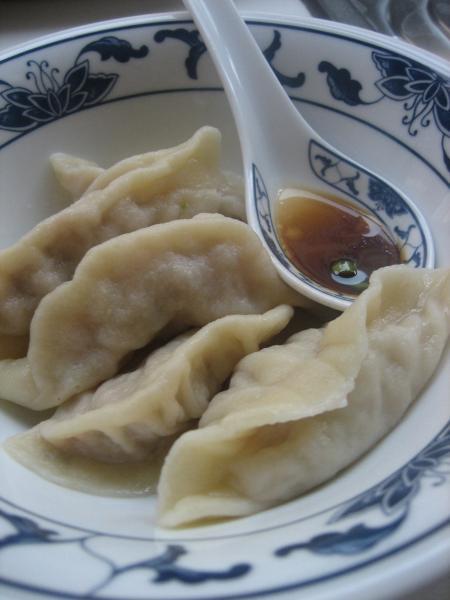-
Posts
2,382 -
Joined
-
Last visited
Content Type
Profiles
Forums
Store
Help Articles
Everything posted by Franci
-
Thank you, both! I first used my oven spray (it has caustic soda), 4-5 times for no more than half and hour each time, but still didn't manage to take everything off (I didn't burned anything so badly I thought) and resorted to the stainless steel scrubber, although after that maybe just an impression but I could see a little bit discoloration. Then I did the re seasoning they suggest. In all honesty, the idea to go though all this fuss every time I want to brown something or something stick to it just gives me an headache. I thought the idea of the honeycomb was so food would not get stuck to the pan .
-
Hello. I recently bought an hexagon frying pan and I'm still struggling a little bit with it, cooking with ceramic hobs is so irritating. I used a stove temperature too high and I ended up with some burned food. I followed the instructions: I soaked it with warm water and washed with mild detergent. The pan is pretty clean in appearance but the honeycomb is all covered with carbonized material and a non scratch sponge doesn't help much. What to do? I was hoping to get to a semi no-stick surface, like for regular cast irons skillets. Any experiences with this pan? Thanks
-
Thanks Nakji, I'll do that. And hopefully I can start using this wok again
-
Yes. I did as you suggested. Here the wok warming up on the stove you can see in the center I scratched too much with sand paper The first paper I think it's kind of burned, I still had the wok on the stove. then I took out of the stove the wok and I flipped over the paper and rubbed with the tongs. Then I took a third paper and came out like this It should be ok, I think. Unfortunately, I tossed the oil without thinking of filtering Would you feel safe cooking in it? I think I did a pretty bad job with sand paper and the wok it's all scratched...
-
Hello, I need a little bit of reassurance Last summer I seasoned a new carbon steel wok but after use it was flaking and I thought maybe I didn't remove properly the protective patina or I didn't season properly. But we were moving house and I just put the wok aside. I just took it out yesterday and was determined to start fresh. It took me a good hour of scrubbing and I wasn't yet done to remove the previous seasoning, so, out of desperation I used some sand paper. Then washed with soapy water and rinsed. Then proceeded to season on the stove, three times. It looks ok but not sure if properly done, I'll post maybe a picture later. Yesterday night I used straight away to deep fry some small fishes, but I really became dubious about using the sand paper and eating carbon steel dust...it seems fine to the touch, do you think I'm just becoming paranoid about it? It is ok?
-
Hey Franci ! i would love to know more about how many boxes of pasta people have open at one time in Italy.... and what shapes? LOL i would think LOTS of boxes for the variety. tell me more.... Well, technically I'm an Italian living in Monaco and I don't eat as much pasta as my parents do. But I have open at the moment: spaghettoni, linguine, spaghetti, bucatini, mezze penne, torciglioni, filini, grattini, ditaloni rigati, gnocchi sardi, tagliatelle, fusilli bucati corti and paccheri. Wow, I didn't think I had so much
-
Do you want to know how many boxes of pasta we keep open in Italy at one time The only time I usually keep under control the quantity of pasta (even if the boxes are closed) is in the summer when it's really hot and you have flour/rice/pulses in the cupboard and if you have flour spoiling or rice then even if you keep in jars you might end up throwing everything out. I have boxes of pasta open for very long time in glass jars.
-
Thanks Snowangel! I got a little bit lost in that topic. So, I guess a major problem I might have had it's just a matter of fat. But if I recall correctly someone was saying that fat is more important in pot stickers (eh, eh, they seem to me already kind of fat on their own). I might try to cut some lardo di colonnata into the ground pork. Folding for me it's easy. I'm Italian and used to closing italian ravioli. Yours, even without the pleating, look very inviting. What's your preference on the filling side? I'm more proud of myself pleating baozi for the first time yesterday and my 2.5 years old son, although half shanghainese, said to me that he prefers italian ravioli but steamed bread was a winner.
-
Thanks, Amy! I also did some pot stickers, leaving the dough a little ticker. Nice crunch. I tried yesterday to make meatballs out of some pork I had left and I just got to the conclusion that I need another cut of pork or need to buy pork somewhere else, although it's a nice shop around here. Next time I'll try the filling first, I don't know why didn't come to me. Being a tired mum. Cheers
-
Hi Doodad, I'm reading very good reviews on the book, do you like it? Nice meal BTW, here is a picture of the filling Considering it was my fist attempt I'm happy about how the dough turned out and the look, need to give it another try soon.
-
From what I've been reading here, the meat in the filling for jiaozi it's ground to a paste. Today I tried the Hunan dumplings from Barbara Tropp's book. The recipe calles for hand cut meat or coarsely ground port butt. I got a neck with good fat grounded by the butcher but, in all honesty, I didn't like the filling much. I'm not sure if it's because I'm used to a different texture or I just found a lacking of seasoning. It is just a Hunan thing to have a coarse texture? Second question. In the recipe she didn't suggest to make a "belly" to the skin. I thought it was kind of the rule for home made jiao zi and also for pot stickers.
-
Did anybody try the Faitout Plume? It's 30% lighter because of a steel lid. In France the price is much lower, 89 € instead of 119 € of a regular same size LC (20 cm). Any thought? Thanks
-
Thanks everybody, very interesting! It's a little bit like Italy, you cut high canadian flour with 00 flour. I'm more familiar with the US/UK/Italian market. In Italy, for ex. if you buy flour in supermarkets it's not displayed the W, only the general use for it,and the Canadian flour it's already "cut" and ready to use. However, for serious home bakers there are some mills who provide all the specifications for flour needed. I guess I was looking some online store like Tibiona for Italy or King Arthur for the US. I'm already thinking of some Panettone baking for Christmas. Well, thanks, I think I need to get used to the products and get familiar with what is available. Thanks for suggesting the book.
-
Hi. Yesterday I found myself really struggling to buy flours. I know that lower numbers are associated with lower protein but beside that I found very difficult to buy flours without added levain or other ingredients. There were tons of packages for brioche or cereal or other kinds of loafs but I didn't manage to find a good, simple, high protein flour for bread making. Is there any mill which sells on line and lists all the specifications for flour (W in particular)? I was looking something like Tibiona for Italy. They sell very good flours, but also cereals, spices etc. Thanks
-
Hello. I've recently moved to Monaco and the area is still very new to me. I'd be really grateful if somebody could suggest some food shopping places around Monaco, small producers and farmers, good bakeries. And also online shopping possibilities. In the last couple months I've been living in Ventimiglia, so I know of the markets on the Italian side and about the Menton market on Saturday but that's about it. Thanks
-
Dry fava beans in Puglia is ALWAYS served hot. The rule is never stir during cooking, just when is soft and the water completely gone. I asked my father, in dialect 'ncapriata referres to the mix, to combine the fava with the cicorie. When I think of 'ncapriata it's much thicker, not as runny as the one I've seen in the pictures here. Sometimes pane casereccio in chunks is added to the fava and cicoria mix. It is usually served along witha an onion and tomato salad (with oil and vinegar!) and deep fried small sweet green peppers (in other parts of Italy called friggitelli, we call it diavulicchi in dialect) This is the classic pignata used to cook fave on the fireplace, that is the best way, when they are done they are vigorously beaten with a long wooden spoon oil is added to make a thick homogeneous mash.
-
No Hathor, they just boil it in salted water, add the pasta, and strain it. I took notice of the size of the flower head, and it seemed to be more developed than what I'm used to seeing. What they do is trim off the big leaves, which, I guess hold alot of bitterness. The yield is much less, but I had success doing it this way. Another trick I've tried with rapi is soaking it in salted wated BEFORE cooking it, which also seemed to do the trick in drawing out bitterness. That way, you don't lose all that love down the drain. ← Cime di rape pugliesi have more flowers and less leaves than the rapini you buy in the States, and of course are more bitter. We leave out the outer leaves because they are tough and will require more cooking time. Hathor, some peole like to precook the cime di rape especially if they are very bitter. I love that bitterness. Cime di rapa are better with very cold weather, like other cabbages. The taste of cime di rapa or other wild herbs is very particular in puglia because of the chalkiness of the soil. Shaya, it'd be durum flour, something a little less coarse than semolina flour and warm water. No resting time. I think it requires long training to get it right, they should be all of the same thickness and the outside should not be too thick, what you don't want basically is ending up eating raw and overcooked pasta. It's not easy to get it right. Hathor, I did not see a rotisseria (?) while there. I was expecting to, but it didn't happen. One night out, at the pizzeria in Giovinazzo, someone in the group brought in gnumerelli for us to try. They were awesome. These are little pieces of the lamb offal, wrapped with a lamb casing, then grilled. They were very good, and I ate a bunch of them. I guess they are pretty labor intensive to make. In my Culinaria Italy book, they show a butcher shop in Martina Franca, that cooks meat on big skewers inside a wood fired oven. One week wasn't enough, but a good start. ← Rosticcerie are actually called by locals also "fornello", the meat on the spit takes the name of carne al fornello. Almost every butcher have a brick oven next to the shop where at night meat is cooked. It's our take out food! Not bad...... Offal rolls, "gnumeridd" means little balls of thread there should be some pictures of mine around of step to step instruction on how to make the bigger versions of them: marretti. My town is basically the next town to Martina Franca
-
Stevarino, great report! I am so glad to hear that you appreciated so much the food from my region. I couldn't refrain to add some comments. And I am taking advantage of this post to say hi to the affezionati of the italian subsection! I hope everybody is fine. Yes, puntarelle belongs to the family of chicory, there are different varieties, this in the picture and another kind where you have a "smaller" head and long leaves of greens, looking like dandelion, we call it "catalogna" and the head of catalogna is also served with other crudita' (celery, radishes, carrots, pagnottelle or caroselli a kind of very sweat round cucumber resemling a small green melon), this plate is called also spingituro (something similar is served in middleastern restaurants), spingituro means "that pushes", helps you eating more..... If you walk around in small towns you will often see bunches of tomatoes hanging from the celings, those are called "winter tomatoes" because you could keep for very long time, they are not good for salads but used for cooking or spreading on friselle or bread. Gallinella di mare "hen" which I never seen in the US is pretty popular in the UK, known also as gurnard fish. Very good for soups. The shrimp on top is called "cicala" or elsewhere in Italy pannocchia or canocchia, it's very cheap and we only buy live cicale, I prefer those to scampi for a quick linguine dish. I have only seen those in the US once at Chinatown in Brooklyn. The evidence continues to mount against that old dictum. Perhaps I react strongly to it since I grew up with it. ← Although when we were dining in a restaurant in Rome we saw a couple ask for cheese for their pasta with shrimp, and were firmly and pointedly denied said cheese! ← Of course, but there is a difference. We'd never add cheese to a pasta dish with shrimps but sometimes, example when we do gratins, we often use a little pecorino to add to bread, It's just a matter of balancing flavors..... Sometimes you can find in markets in NY, Astoria. I am sure it grows wild in the US, look for the scientific name.
-

The Cooking and Cuisine of Basilicata and Calabria
Franci replied to a topic in Italy: Cooking & Baking
This is another dish in common, here is how it is done capuzzelle -

The Cooking and Cuisine of Basilicata and Calabria
Franci replied to a topic in Italy: Cooking & Baking
Grano is wheat berries. Yes, a ragu' with grano is cooked in the same way in Puglia too. Grana means something different. -

The Cooking and Cuisine of Basilicata and Calabria
Franci replied to a topic in Italy: Cooking & Baking
MrBig, I tried to google for you because I never had this polenta. I found out that: * there is a polenta fair in Nemoli, Potenza, where the polenta is served with a sauce made with sausage, pancetta and the crumbled red peppers *there is a dish called "carchiola", try to google that. The recipe in English call for rape, in the Italian recipes I see that is mainly referred to a corn focaccia served with savoy cabbage. Now, I cannot tell you if some lucani who moved to the States changed the recipe or there is a village where actually this polenta and rape is cooked. *I found out looking in the Proloco web site of Comune di Picerno (famous for lucanica) that they do a corn focaccia with lard, cracklings, raisins, cheese and horseradish! I'll look between my books if I can find something else -

The Cooking and Cuisine of Basilicata and Calabria
Franci replied to a topic in Italy: Cooking & Baking
It took me a while to find out. Here in this blog you can roughly see how these pastries are shaped. But I found out that the same tool is used in Sicily for another sweet, from Delia, Caltanissetta: la cuddrireddra -

The Cooking and Cuisine of Basilicata and Calabria
Franci replied to a topic in Italy: Cooking & Baking
Ah, and about parmigiana beeing calabrese, I think some campani would not agree, there is a huge disagreement about it. -

The Cooking and Cuisine of Basilicata and Calabria
Franci replied to a topic in Italy: Cooking & Baking
Beeing Basilicata my neighbouring region I have been there quite often. It's pretty isolated, a lot of small villages on top of mountains, traditions there are still quite strong. I remember going there especially for religious fairs, la festa della madonna di Viggiano is pretty famous, or some other festivities, for ex. in San Mauro Forte, in January, there is the festa del campanaccio where fires are build all around the village and the villagers go around with huge bells for two days , this marks the starting of Carnival. They use to go from one cantina to the other drinking robut red wine and eating even more robust food, I rememeber a sheep stew in particular. Really delicious their salumi: salami piccanti, capocollo and cheese. Manteca is a specialty around the area: it looks like a caciocavallo but it has a heart of butter. Bread is truly really good, think of the tradition of pane di Matera, as famous as Altamura bread in the South. The food of Basilicata is not very different than the pugliese food from the inside. Same kind of pasta (orecchiette, strascinati, maccheroni col ferretto), a lot of lamb and vegetables, but beeing in the mountain they have also a lot of mushrooms (a lot of porcini in Calabria), a lot of wild board hunting and wild herbs. Here I have some pictures of things my parents brought back for me on the last trip to Calabria. They have been to Altomonte, a very nice village around the Pollino, maybe the closest destination for skiing for pugliesi. The Barbieri hotel and restaurantwas a very good experience for my father These dry peppers are not spicy, they are called peperoni kruski, these actually were from Altomonte but the most famous with IGP (Indicazione geografica protetta) are the Kruski from Senise in Lucania. You open them, take out the seeds and put in a pan with oil for seconds until they pop up, it should be done very quickly, if the pepper burns turns out bitter. They are eaten as chips as appetizer. Could be sweet or spicy. I know there is a very popular dish with these pepper and scrumble eggs. These, still from Altomonte, were called seccatini, if I rememeber correctly Sorry, bad picture. They are dried strips of gourd, to be cooked they need to soaked in water. There is a huge tradition of preserved vegetables: dry tomatoes, tomato paste and underoils in genaral (spicy eggplants, stuffed peperoncini, mushrooms and so on). Have you ever heard of bomba? A spicy calabrese veg paste? Or 'nduja? it is a salame spread very, very spicy. I also got from my mom this tool to add to my collection it looks almost like the "comb" they use in Emilia Romagna for garganelli, in Calabria it is used for a fried sweet dipped in honey, similar concept than cartellate in Puglia but different shape. -
Thanks, FoodMan. The scrippelle are made using a batter of one egg per person, flour and water. A little research has taught me that they are also known as scrippelle ’mbuse (which means soaked - which might explain Hathor's question above). From what I gather they are really crespelle which, when rolled with cheese and served with broth take on the regional name of scrippelle. That said, I have made Batali's so-called crespelle many times, and they use a small number of eggs, milk and flour. Perhaps the use of milk is his more elevated improvisation of a poor-man's dish? ← I have only seen fully covered with broth and the crepe with no milk, at least all the recipes I have encountered.


